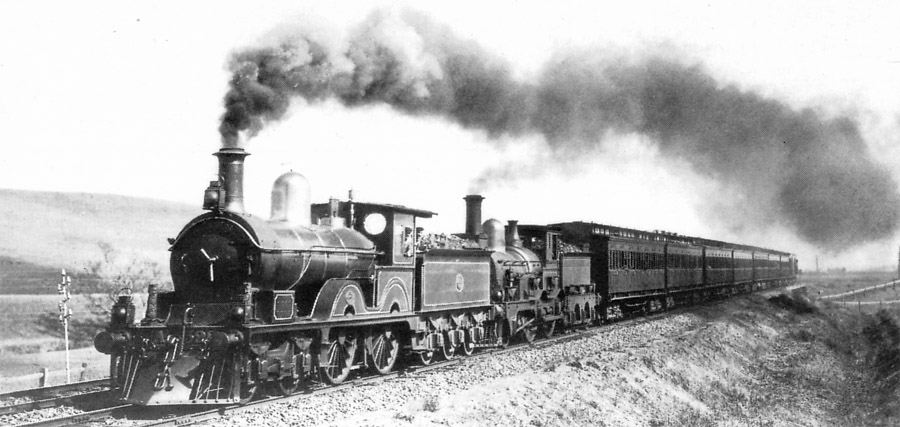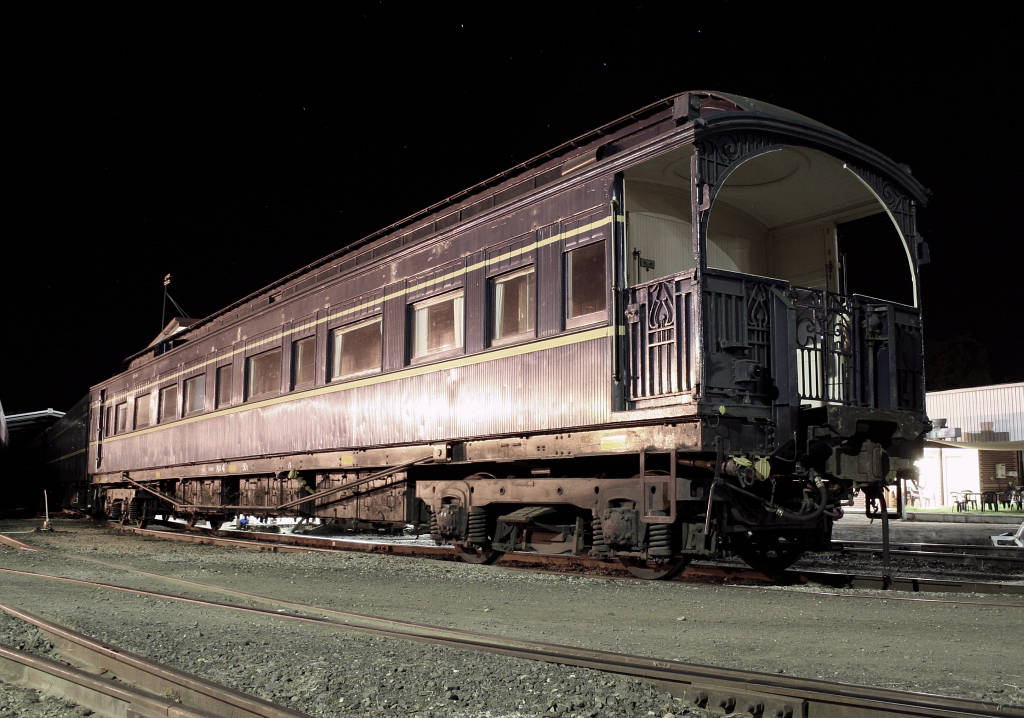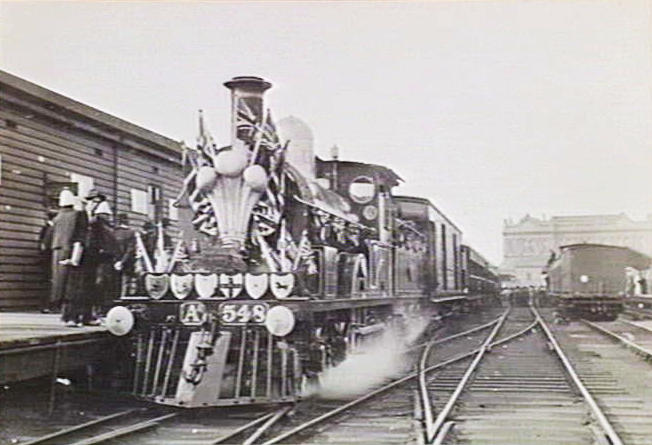|
Victorian Railways B Class (1861)
The Victorian Railways B class was a class of passenger locomotives operated by the Victorian Railways (VR) between 1862 and 1917, built by various builders. The B class locomotives are regarded as the first mainline VR motive power, and were highly successful in passenger operations. History Victorian Railways initially numbered passenger and goods locomotives separately, the engines were delivered with numbers 32–51, 64–69, 82–87. This system was changed before these locos entered service to odd numbers for goods locomotives and even numbers for passenger locos with these locomotives taking the even numbers 46–96, 102–112, 186–188. This odd and even system remained in use until 1912. In 1886, they were allocated to Class B. Production The first order for seven locomotives was placed with R and W Hawthorn in February 1861 and in April 1861 for seven locomotives of the same design with Beyer, Peacock & Company. These were extended to, a further six from Hawthorn ... [...More Info...] [...Related Items...] OR: [Wikipedia] [Google] [Baidu] |
Beyer, Peacock & Company
Beyer, Peacock and Company was an English railway locomotive manufacturer with a factory in Openshaw, Manchester. Founded by Charles Beyer, Richard Peacock and Henry Robertson, it traded from 1854 until 1966. The company exported locomotives, and machine tools to service them, throughout the world. Founders German-born Charles Beyer had undertaken engineering training related to cotton milling in Dresden before moving to England in 1831 aged 21. He secured employment as a draughtsman at Sharp, Roberts and Company's Atlas works in central Manchester, which manufactured cotton mill machinery and had just started building locomotives for the Liverpool and Manchester Railway. There he was mentored by head engineer and prolific inventor of cotton mill machinery, Richard Roberts. By the time he resigned 22 years later he was well established as the company's head engineer; he had been involved in producing more than 600 locomotives. Richard Peacock had been chief engineer of the Ma ... [...More Info...] [...Related Items...] OR: [Wikipedia] [Google] [Baidu] |
Victorian Railways Royal Train
The Victorian Railways' (VR) Royal Trains operated to transport members of the Royal Family on their numerous tours of Australia on the Victorian rail network. The same carriages were also used for a number of vice-regal trains for the Governor-General of Australia and the Governor of Victoria. The last Royal Train ran in 1988. Operation Royal trains usually operated with special carriage stock set aside for the purpose. Most trains operated with double headed locomotives to reduce the chance of the train being stranded due to locomotive failure, with a third locomotive running in front of the train to ensure the track was clear. A special headboard with the royal coat of arms was usually affixed to the front of the leading locomotive. Carriages In the history of the Victorian Railways there were five special carriages designated for royal train and other special services, designated State Car 1 through to State Car 5. From 1954, the carriages were painted in the standard ... [...More Info...] [...Related Items...] OR: [Wikipedia] [Google] [Baidu] |
Victorian Railways O Class (1861)
The Victorian Railways O class was a class of goods locomotives operated by the Victorian Railways between 1862 and 1922, built by various builders. History Victorian Railways initially numbered passenger and goods locomotives separately, the engines were delivered with numbers 26–31, 52–63, 70–81, 88–89. This system was changed before these locos entered service to odd numbers for goods locomotives and even numbers for passenger locos with these locomotives taking the odd numbers 19–81, 127–149. This odd and even system remained in use until 1912. In 1886, they were allocated to Class O. Production The first order for six locomotives was placed with Slaughter, Gruning & Co. (builder's numbers 460–465) in April 1861 and twelve locomotives with Robert Stephenson & Company (B/n 1441–1452) in January 1862. The locomotives built by Slaughter, Grüning (B/n 231–237, 261–266) arrived in Port Phillip June 1862, and the Robert Stephenson ones in October 1862. In J ... [...More Info...] [...Related Items...] OR: [Wikipedia] [Google] [Baidu] |
Port Fairy Railway Line
The Warrnambool railway line (also known as the South West line, formerly known as the Port Fairy railway line) is a railway serving the south west of Victoria, Australia. Running from the western Melbourne suburb of Newport through the cities of Geelong and Warrnambool, the line once terminated at the coastal town of Port Fairy before being truncated to Dennington (just west of Warrnambool). This closed section of line has been converted into the 37 km long Port Fairy to Warrnambool Rail Trail. The line continues to see both passenger and freight services today. Services Metro Trains Melbourne operates suburban passenger services along the inner section of the line as far as Werribee, while V/Line operates the Geelong and the Warrnambool services. For 11 years, from 19 September 1993 until 31 August 2004, the Melbourne to Warrnambool passenger service was run by the private West Coast Railway company. Freight services also run on the line, operated by Pacific National ... [...More Info...] [...Related Items...] OR: [Wikipedia] [Google] [Baidu] |
Railway Accidents In Victoria
There have been a number of train accidents on the railway network of Victoria, Australia. Some of these are listed below. Fatal accidents North Geelong, 1857 On 25 June 1857, the inaugural train of the Geelong and Melbourne Railway Company left Geelong at 10 a.m., bound for the company's temporary Melbourne terminus at Greenwich (now Newport). When the train passed under the road overpass adjacent to the Ocean Child Hotel in North Geelong, Henry Walter, the locomotive superintendent of the company, was knocked off the locomotive and fatally injured. Jolimont, 1881 On 30 August 1881, the first accident in Victoria involving passenger deaths and multiple injuries occurred. Four passengers were killed, and 39 were injured, when a tyre broke on one of the wheels of the 8:54am express from Brighton to Flinders Street Station, causing the derailment of five carriages near Jolimont. The first car to leave the rails, the fourth in a train of nine, was dragged along the metals for some d ... [...More Info...] [...Related Items...] OR: [Wikipedia] [Google] [Baidu] |
Tractive Effort
As used in mechanical engineering, the term tractive force can either refer to the total traction a vehicle exerts on a surface, or the amount of the total traction that is parallel to the direction of motion. In railway engineering, the term tractive effort is often used synonymously with tractive force to describe the pulling or pushing capability of a locomotive. In automotive engineering, the terms are distinctive: tractive effort is generally higher than tractive force by the amount of rolling resistance present, and both terms are higher than the amount of drawbar pull by the total resistance present (including air resistance and grade). The published tractive force value for any vehicle may be theoretical—that is, calculated from known or implied mechanical properties—or obtained via testing under controlled conditions. The discussion herein covers the term's usage in mechanical applications in which the final stage of the power transmission system is one ... [...More Info...] [...Related Items...] OR: [Wikipedia] [Google] [Baidu] |
Railway Air Brake
A railway air brake is a railway brake power braking system with compressed air as the operating medium. Modern trains rely upon a fail-safe air brake system that is based upon a design patented by George Westinghouse on April 13, 1869. The Westinghouse Air Brake Company was subsequently organized to manufacture and sell Westinghouse's invention. In various forms, it has been nearly universally adopted. The Westinghouse system uses air pressure to charge air reservoirs (tanks) on each car. Full air pressure causes each car to release the brakes. A subsequent reduction or loss of air pressure causes each car to apply its brakes, using the compressed air stored in its reservoirs. Overview Straight air brake In the air brake's simplest form, called the ''straight air system'', compressed air pushes on a piston in a cylinder. The piston is connected through mechanical linkage to brake shoes that can rub on the train wheels, using the resulting friction to slow the train. Th ... [...More Info...] [...Related Items...] OR: [Wikipedia] [Google] [Baidu] |
Westinghouse Air Brake Company
The Westinghouse Air Brake Company (sometimes nicknamed or abbreviated WABCO although this was also confusingly used for spinoffs) was founded on September 28, 1869 by George Westinghouse in Pittsburgh, Pennsylvania. Earlier in the year he had invented the railway air brake in New York state. After having manufactured equipment in Pittsburgh for a number of years, he began to construct facilities and plants east of the city where homes for his employees were built. In 1889, the air brake manufacturing facility was moved to Wilmerding, Pennsylvania, and the company's general office building was built there in 1890. In 1921 the company began manufacturing a modified air brake system for installation in trucks and heavy vehicles. In 1953 WABCO entered the heavy equipment marketplace, buying the assets of leading equipment designer R.G LeTourneau. An entity known as LeTourneau-Westinghouse sold a range of innovative products, including scrapers, cranes and bulldozers until 196 ... [...More Info...] [...Related Items...] OR: [Wikipedia] [Google] [Baidu] |
Southern Cross Railway Station
Southern Cross railway station (until 2005 known as Spencer Street station) is a major railway station in Docklands, Victoria, Docklands, Melbourne. It is on Spencer Street, Melbourne, Spencer Street, between Collins Street, Melbourne, Collins and La Trobe Street, Melbourne, La Trobe Streets, at the western edge of the Melbourne city centre, Melbourne central business district. The Docklands Stadium sports arena is 500 metres north-west of the station. The station is owned, operated and maintained by Civic Nexus, a subsidiary of IFM Investors and operating as Southern Cross Station Pty Ltd, under a 30-year lease to 2036 from the Victorian State Government, as part of a public-private partnership. Southern Cross Station Pty Ltd contracts Infranexus Management Pty Ltd (Infranexus) for management services. Infranexus is also wholly owned by IFM. The station is the terminus of the List of regional railway stations in Victoria, state's regional railway network operated by V/Line, ' ... [...More Info...] [...Related Items...] OR: [Wikipedia] [Google] [Baidu] |
Double Heading
In railroad terminology, double heading indicates the use of two locomotives at the front of a train, each operated individually by its own crew. The practice of triple-heading involves the use of three locomotives. The practice of multi-heading involves the use of multiple locomotives and so on. Double heading is most common with steam locomotives, but is also practised with diesel locomotives. It is not strictly the same practice as two or more diesel or electric locomotives working ' in multiple' (or 'multiple-working'), where both (or all) locomotives are controlled by a single driver in the cab of the leading locomotive. Advantages Double heading is practised for a number of reasons: * In the UK it was usually to gain traction on steep inclines, twice the amount of driven wheels - twice the amount of grip. * The need for additional motive power when a single locomotive is unable to haul the train due to uphill grades, excessive train weight, or a combination of the two ... [...More Info...] [...Related Items...] OR: [Wikipedia] [Google] [Baidu] |
Victorian Railways AA Class
The AA class was an express passenger locomotive that ran on the Victorian Railways between 1900 and 1932. The largest, heaviest and most powerful 4-4-0 steam locomotive to run in Australia, it was the final development of this locomotive type in Australia. History In 1900, Victorian Railways still ran express passenger trains with the successful but ageing B class 2-4-0 which dated back to 1862. The 'New A' class 4-4-0 of 1889 had proven to be a successful design, as had its close cousin and exact contemporary the X class 0-6-0. With traffic needs continuing to grow, the VR drafting office decided to take the best features of the New A and X class, but enlarge the locomotive with a larger, higher pressure boiler and larger cylinders. Design features Innovative design features of the AA class included air sanding equipment, improved Gresham No. 9 injectors, horizontal grid spark arrestors, steam for auxiliaries supplied directly from the dome, and a sloped ashpan to provide eas ... [...More Info...] [...Related Items...] OR: [Wikipedia] [Google] [Baidu] |
Victorian Railways 'New' A Class (1889)
Victorian or Victorians may refer to: 19th century * Victorian era, British history during Queen Victoria's 19th-century reign ** Victorian architecture ** Victorian house ** Victorian decorative arts ** Victorian fashion ** Victorian literature ** Victorian morality ** Victoriana Other * ''The Victorians'', a 2009 British documentary * Victorian, a resident of the state of Victoria, Australia * Victorian, a resident of the provincial capital city of Victoria, British Columbia, Canada * RMS ''Victorian'', a ship * Saint Victorian (other), various saints * Victorian (horse) * Victorian Football Club (other), either of two defunct Australian rules football clubs See also * Neo-Victorian, a late 20th century aesthetic movement * Queen Victoria * Victoria (other) Victoria most commonly refers to: * Victoria (Australia), a state of the Commonwealth of Australia * Victoria, British Columbia, provincial capital of British Columbia, Canada * Victoria ( ... [...More Info...] [...Related Items...] OR: [Wikipedia] [Google] [Baidu] |

.jpg)





